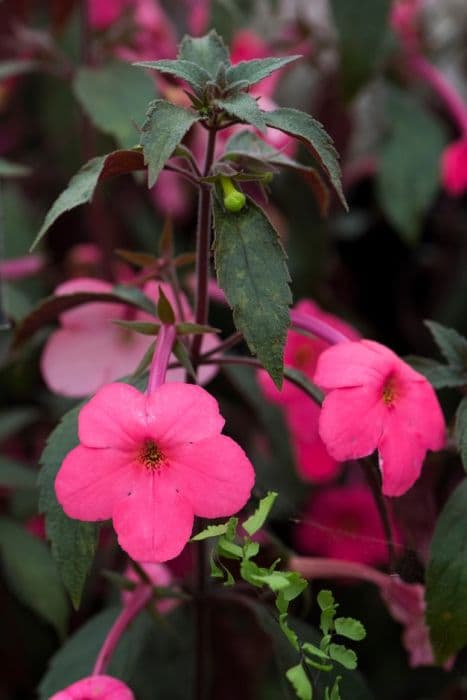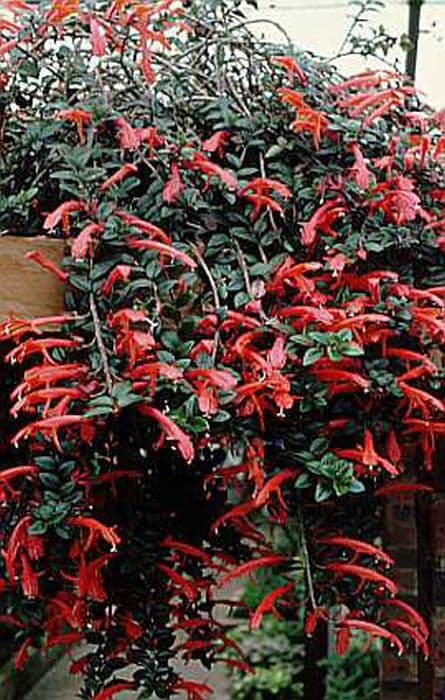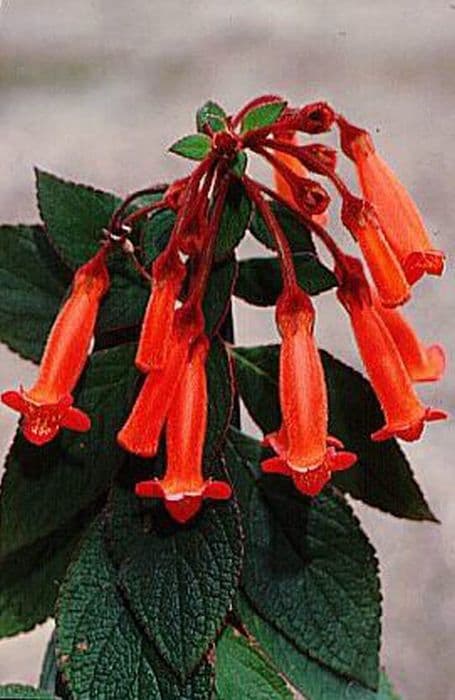Cape Primrose Streptocarpus 'Jennifer'

ABOUT
Streptocarpus 'Jennifer' is an ornamental houseplant known for its beautiful and distinctive foliage and blooms. This variety typically showcases lush, velvety leaves that are elongated and have a slight wave to the edges, giving them an attractive, textured look. The foliage grows in a rosette pattern, spreading outwards and forming a dense cluster of green. The flowers of Streptocarpus 'Jennifer' are particularly striking. They bloom in clusters on slender, tall stalks that emerge from the rosette of leaves. Each trumpet-shaped flower presents with a soft, pastel hue, ranging from pale lilac to soft pink, often featuring intricate patterns or throat markings that may include deeper shades or contrasting colors like yellow or white. The blooms are comprised of five petals with a velvety appearance, which can sometimes showcase ruffled or frilled edges, adding to their charm. Throughout its blooming period, the plant produces a profusion of these delicate flowers, creating a spectacular display that adds color and vibrancy to any indoor space. The blooms, coupled with the green foliage, give Streptocarpus 'Jennifer' a lush, ornamental look that is popular among plant enthusiasts and those looking for a visually appealing houseplant.
About this plant
 Names
NamesSynonyms
Cape Primrose, African Violet Cousin, Nodding Violet, Twisted Seed Plant.
Common names
Streptocarpus 'Jennifer'.
 Toxicity
ToxicityTo humans
Cape Primrose (Streptocarpus 'Jennifer') is generally not considered toxic to humans. There are no well-documented cases of poisoning from this plant, and it is not known to contain any harmful substances that would cause serious illness if ingested. However, it is not intended for consumption, and eating any part of the plant may cause mild stomach upset in some individuals due to the presence of saponins, which can be an irritant.
To pets
Cape Primrose (Streptocarpus 'Jennifer') is also not known to be toxic to pets. It is not listed on common toxic plant lists for pets such as those provided by the ASPCA (American Society for the Prevention of Cruelty to Animals). Therefore, if a pet were to ingest a small amount of the plant, it is unlikely to cause serious harm. However, as with humans, ingestion is not recommended and may lead to mild gastrointestinal upset in some pets.
 Characteristics
CharacteristicsLife cycle
Perennials
Foliage type
Evergreen
Color of leaves
Green
Flower color
Varies
Height
1 foot (30 cm)
Spread
1 foot (30 cm)
Plant type
Herb
Hardiness zones
10
Native area
Africa
Benefits
 General Benefits
General Benefits- Easy to care for: Streptocarpus 'Jennifer', also known as Cape Primrose, is relatively low maintenance, making it suitable for those new to gardening or with limited time.
- Long blooming period: Cape Primrose is known for its long flowering season, often blooming continuously for several months with proper care.
- Attractive foliage: The plant features attractive, velvety leaves that add a lush green presence to any indoor space.
- Variety of colors: It produces flowers in a range of colors, adding a vibrant splash to your home or garden.
- Compact size: Its compact growth habit makes it an ideal choice for small spaces like apartments or small gardens.
- Indoor and outdoor versatility: Cape Primrose can be grown both indoors as a houseplant and outdoors in suitable climates, offering flexibility to gardeners.
- Brightens up spaces: The plant's colorful blossoms can brighten up living spaces, workspaces, and shaded garden areas.
- Can be used in mixed containers: Its size and shape make it suitable for mixed planters, adding texture and color variety.
 Medical Properties
Medical PropertiesThis plant is not used for medical purposes.
 Air-purifying Qualities
Air-purifying QualitiesThis plant is not specifically known for air purifying qualities.
 Other Uses
Other Uses- Crafting Botanical Prints: The Streptocarpus 'Jennifer', commonly known as Cape Primrose, can be pressed and used to create delicate botanical prints for artwork or educational purposes.
- Photography Subject: Because of its attractive blooms, Cape Primrose is often used as a subject for photographers looking to capture the beauty of unique floral subjects.
- Teaching Tool in Botany: Educators can use Cape Primrose to teach students about plant biology, flower structure, and the life cycle of angiosperms.
- Color Inspiration for Designers: Artists and designers may draw color inspiration from the beautiful shades of Cape Primrose flowers for various design projects.
- Therapeutic Horticulture: Cultivating Cape Primrose can be a part of therapeutic horticulture programs, which focus on nurturing plants to improve well-being.
- Event Decorations: The vibrant flowers can serve as natural decorations at events, such as weddings or garden parties, adding a splash of color to tables and arrangements.
- Gardening Skill Development: Caring for the Streptocarpus 'Jennifer' can help hobby gardeners develop their skills, as it requires specific conditions to thrive.
- Educational Crafts for Children: The plant can be used in craft projects for children, teaching them about nature while they create art using its petals and leaves.
- Experimentation in Plant Breeding: Amateur gardeners and horticulturists might use Cape Primrose as a candidate for cross-pollination attempts to breed new hybrids.
- Culinary Presentation: Although not to be consumed, the non-toxic flowers can garnish dishes for an elegant presentation at fancy dinners, before being removed prior to eating.
Interesting Facts
 Feng Shui
Feng ShuiThe Cape Primrose is not used in Feng Shui practice.
 Zodiac Sign Compitability
Zodiac Sign CompitabilityThe Cape Primrose is not used in astrology practice.
 Plant Symbolism
Plant Symbolism- Persistence: Streptocarpus, commonly known as Cape Primrose, typically symbolizes persistence due to its ability to flower multiple times and survive in moderate conditions.
- Endurance: This plant can endure varying light conditions which is often seen as a symbol for enduring through life's challenges.
- Hope and Renewal: With its continuous blooming cycle, the Cape Primrose represents hope and the constant renewal of opportunities.
- Long-lasting love: Since it can live for many years with proper care, it's sometimes used to symbolize long-lasting love and relationships.
 Water
WaterTo water a Cape Primrose (Streptocarpus 'Jennifer'), allow the top inch of soil to dry out between waterings. Generally, this means watering about once a week, but this can vary depending on environmental conditions. Use room temperature water and gently water at the base of the plant, avoiding the leaves to prevent rot. Provide enough water so that it runs through the drainage holes, which might be around two to four ounces for a small pot. Adjust the amount based on the size of your pot and the plant's response over time.
 Light
LightCape Primrose thrives in bright, indirect light but can tolerate moderate shade. The best spot for the plant would be a north-facing or east-facing window, where it gets plenty of light without the harsh direct sun, particularly in the afternoon which can scorch its leaves. Avoid placing it in full shade or overly dim areas, as this can lead to poor flowering and leggy growth.
 Temperature
TemperatureCape Primroses prefer moderate temperatures and should be kept in a range between 60°F and 75°F for optimal growth. They can tolerate temperatures down to about 50°F, but cold drafts and temperatures below this can cause harm. The plant's ideal conditions exclude extremes; avoid placing it near heating vents or air conditioning units that can create sudden temperature fluctuations.
 Pruning
PruningPrune your Cape Primrose to remove any dead or yellowing leaves to encourage healthy growth and improve air circulation. Pruning is also necessary to remove spent flower stalks, which promotes additional blooming. The best time to prune is immediately after flowering or during the active growing season. Pruning can be done every few months or as needed to maintain the shape and size of the plant.
 Cleaning
CleaningAs needed
 Soil
SoilThe best soil mix for Cape Primrose (Streptocarpus 'Jennifer') should be light and well-draining, consisting of a blend of peat moss, perlite, and vermiculite in equal parts. Aim for a slightly acidic to neutral pH, ideally between 6.0 and 7.0.
 Repotting
RepottingCape Primrose should be repotted when it outgrows its container, typically every 1 to 2 years. Ensure that the new pot is only slightly larger than the old one to avoid excess soil moisture.
 Humidity & Misting
Humidity & MistingCape Primrose thrives in moderate to high humidity levels, ideally between 50% and 70%. Avoid extremely low humidity as it can cause stress to the plant.
 Suitable locations
Suitable locationsIndoor
Place in bright, indirect light and keep soil moist.
Outdoor
Grow in shade with shelter from harsh weather.
Hardiness zone
10-11 USDA.
 Life cycle
Life cycleCape Primrose 'Jennifer' begins its life as a seed, typically germinating in moist, well-drained soil with partial to full shade conditions. Upon sprouting, it enters a vegetative stage, developing a rosette of fuzzy, green leaves and slowly maturing over several weeks to months. During its flowering stage, Cape Primrose 'Jennifer' produces vibrant, trumpet-shaped flowers that can bloom almost continuously throughout the year if given proper care. Following pollination, the plant may produce small, dry fruit capsules containing seeds, completing its reproductive cycle. If conditions are favorable, Cape Primrose 'Jennifer' can live for several years as a perennial, during which it can be propagated vegetatively by leaf cuttings to produce new plants. As it ages, the plant may become leggy and can be rejuvenated by pruning or propagating from fresh cuttings to start the cycle anew.
 Propogation
PropogationPropogation time
Spring-Early Summer
The Streptocarpus 'Jennifer', commonly known as Cape primrose, can be propagated most effectively through leaf cuttings. This method is best undertaken in spring or early summer when the plant's growth is most active. To propagate by leaf cuttings, a healthy, mature leaf is chosen and a shallow, diagonal cut is made across the leaf to create smaller sections, each with a bit of the main vein. These cuttings, typically 2 to 3 inches long (about 5 to 7.5 centimeters), are then placed in a moist potting mix, ensuring that the cut edge is in contact with the soil. The cutting should be kept warm, around 70°F (21°C), and maintained in high humidity - covering with a plastic bag can aid in retaining moisture. Roots will usually develop within a few weeks, and new shoots will emerge, which, once established, can be transplanted into individual pots to grow as new plants.









